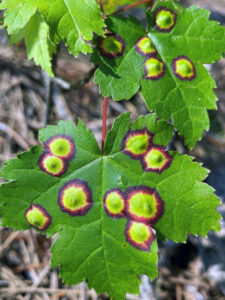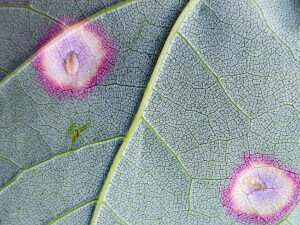
Maple eyespot galls create colorful, concentric patterns on red maple leaves. / Photo Credit: Linda Williams, Wisconsin DNR
By Linda Williams, DNR Forest Health Specialist
Linda.Williams@wisconsin.gov or 920-360-0665
Colorful “bull’s-eye” spots on maple leaves are maple eyespot galls, caused by the tiny ocellate gall midge (Acericecis ocellaris).
The adult midge lays eggs on the underside of the leaves. Once the eggs have hatched, the larvae feed on the leaves. That feeding causes the leaf to develop telltale colorful, concentric circles in that area of the leaf.

Tiny, clear larvae can be spotted at the centers of the colored circles from maple eyespot galls. The spots show up much brighter on the top of the leaf. / Photo Credit: Linda Williams, Wisconsin DNR
A single, tiny larva lives on the underside of the leaf at the center of the colorful bull’s-eye. Larvae feed for 8-10 days, achieving the size of 1/16-inch in length, and then drop to the ground to pupate, where they spend the remainder of the year.
There is only one generation per year, but the bull’s-eye spots will remain on the leaves throughout the growing season. Red maple is the preferred host, but these galls can also be found on sugar maple and silver maple.
Problems that might look similar include fungal leaf diseases, such as anthracnose or septoria leaf spot, and tar spot, which starts as brown spots on the leaf and eventually develops the typical raised, black spots characteristic of tar spot.
The damage from this insect is cosmetic and does not affect the health of the tree. No control of maple eyespot gall is necessary.
